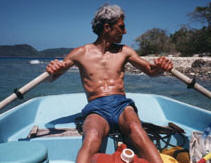Eating Disorders: Thin Battle

Despite what my intellect told me, my goal became to rid my body of all fat. I resumed exercising. I found I could walk good distances, despite some discomfort, if I iced my knees afterward. I started walking several times a day. I built a small pool in my basement and swam in place, tethered to the wall. I biked as much as I could tolerate. The denial of what I only much later came to recognize as anorexia involved overuse injuries as I sought medical help for tendonitis, muscle and joint pain, and entrapment neuropathies. I was never told that I was exercising too much, but I am sure that had I been told, I would not have listened.
Worst Nightmare
Despite my efforts, my worst nightmare was happening. I felt and saw myself as fatter than ever before, even though I had started to lose weight. Whatever I had learned about nutrition in medical school or read in books, I perverted to my purpose. I obsessed about protein and fat. I increased the number of egg whites that I ate a day to 12. If any yolk leaked into my concoction of egg whites, Carnation Instant Breakfast, and skim milk, I threw the entire thing out.
"It Seemed I could never walk far enough or eat little enough."
As I became more restrictive, caffeine became more and more important and functional for me. It staved off my appetite, although I didn't let myself think about it that way. Coffee and soda perked me up emotionally and focused my thinking. I really do not believe that I could have continued to function at work without caffeine.
I relied equally on my walking (up to six hours a day) and restrictive eating to fight fat, but it seemed I could never walk far enough or eat little enough. The scale was now the final analysis of everything about me. I weighed myself before and after every meal and walk. An increase in weight meant I had not tried hard enough and needed to walk farther or on steeper hills, and eat less. If I lost weight, I was encouraged and all the more determined to eat less and exercise more. However, my goal was not to be thinner, just not fat. I still wanted to be "big and strong" -- just not fat.
Besides the scale, I measured myself constantly by assessing how my clothes fit and felt on my body. I compared myself to other people, using this information to "keep me on track." As I had when I compared myself to others in terms of intelligence, talent, humor, and personality, I fell short in all categories. All of those feelings were channeled into the final "fat equation."
During the last few years of my illness, my eating became more extreme. My meals were extremely ritualistic, and by the time I was ready for dinner, I had not eaten all day and had exercised five or six hours. My suppers became a relative binge. I still thought of them as "salads," which satisfied my anorexia nervosa mind. They evolved from just a few different types of lettuce and some raw vegetables and lemon juice for dressing to rather elaborate concoctions. I must have been at least partly aware that my muscles were wasting away because I made a point of adding protein, usually in the form of tuna fish. I added other foods from time to time in a calculated and compulsive way. Whatever I added, I had to continue with, and usually in increasing amounts. A typical binge might consist of a head of iceberg lettuce, a full head of raw cabbage, a defrosted package of frozen spinach, a can of tuna, garbanzo beans, croutons, sunflower seeds, artificial bacon bits, a can of pineapple, lemon juice, and vinegar, all in a foot-and-a-half-wide bowl. In my phase of eating carrots, I would eat about a pound of raw carrots while I was preparing the salad. The raw cabbage was my laxative. I counted on that control over my bowels for added reassurance that the food was not staying in my body long enough to make me fat.
"I awoke at 2:30 or 3:00 a.m. and started my walks."
The final part of my ritual was a glass of cream sherry. Although I obsessed all day about my binge eating, I came to depend on the relaxing effect of the sherry. My long-standing insomnia worsened as my eating became more disordered, and I became dependent on the soporific effect of alcohol. When I was not in too much physical discomfort from the binge, the food and alcohol would put me to sleep, but only for about four hours or so. I awoke at 2:30 or 3:00 a.m. and started my walks. It was always in the back of my mind that I would not be accruing fat if I wasn't sleeping. And, of course, moving was always better than not. Fatigue also helped me modify the constant anxiety I felt. Over-the-counter cold medications, muscle relaxants, and also gave me relief from my anxiety. The combined effect of medication with low blood sugar was relative euphoria.
Oblivious to Illness
While I was living this crazy life, I was carrying on my psychiatric practice, much of which consisted of treating eating-disorder patients -- anorexic, bulimic, and obese. It is incredible to me now that I could be working with anorexic patients who were not any sicker than I was, even healthier in some ways, and yet remain completely oblivious to my own illness. There were only extremely brief flashes of insight. If I happened to see myself in a mirrored window reflection, I would be horrified at how emaciated I appeared. Turning away, the insight was gone. I was well aware of my usual self-doubts and insecurities, but that was normal for me. Unfortunately, the increasing spaciness that I was experiencing with weight loss and minimal nutrition was also becoming "normal" for me. In fact, when I was at my spaciest, I felt the best, because it meant that I was not getting fat.
Only occasionally would a patient comment on my appearance. I would blush, feel hot, and sweat with shame but not recognize cognitively what he or she was saying. More surprising to me, in retrospect, was never having been confronted about my eating or weight loss by the professionals with whom I worked all during this time.I remember a physician administrator of the hospital kidding me occasionally about eating so little, but I was never seriously questioned about my eating, weight loss, or exercise. They all must have seen me out walking for an hour or two every day regardless of the weather. I even had a down-filled body suit that I would put over my work clothes, allowing me to walk no matter how low the temperature. My work must have suffered during these years, but I did not notice or hear about it.
"During those years, I was virtually friendless."
People outside of work seemed relatively oblivious as well. Family registered concern about my overall health and the various physical problems I was having but were apparently completely unaware of the connection with my eating and weight loss, poor nutrition, and excessive exercise. I was never exactly gregarious, but my social isolation became extreme in my illness. I declined social invitations as much as I could. This included family gatherings. If I accepted an invitation that would include a meal, I would either not eat or bring my own food. During those years, I was virtually friendless.
I still find it hard to believe that I was so blind to the illness, especially as a physician aware of the symptoms of anorexia nervosa. I could see my weight dropping but could only believe it was good, despite conflicting thoughts about it. Even when I started feeling weak and tired, I did not understand. As I experienced the progressive physical sequelae of my weight loss, the picture only grew murkier. My bowels stopped functioning normally, and I developed severe abdominal cramping and diarrhea. In addition to the cabbage, I was sucking on packs of sugarless candies, sweetened with Sorbitol to diminish hunger and for its laxative effect. At my worst, I was spending up to a couple of hours a day in the bathroom. In the winter I had severe Raynaud's Phenomenon, during which all the digits on my hands and feet would become white and excruciatingly painful. I was dizzy and lightheaded. Severe back spasms occurred occasionally, resulting in a number of ER visits by ambulance. I was asked no questions and no diagnosis was made despite my physical appearance and low vital signs.
"More trips to the ER still resulted in no diagnosis. Was it because I was a man?"
Around this time I was recording my pulse down into the 30s. I remember thinking that this was good because it meant that I was "in shape." My skin was paper thin. I became increasingly tired during the day and would find myself almost dozing off while in sessions with patients. I was short of breath at times and would feel my heart pound. One night I was shocked to discover that I had pitting edema of both legs up to my knees. Also around that time, I fell while ice skating and bruised my knee. The swelling was enough to tip the cardiac balance, and I passed out. More trips to the ER and several admissions to the hospital for assessment and stabilization still resulted in no diagnosis. Was it because I was a man?
I was finally referred to the Mayo Clinic with the hope of identifying some explanation for my myriad of symptoms. During the week at Mayo, I saw almost every kind of specialist and was tested exhaustively. However, I was never questioned about my eating or exercise habits. They only remarked that I had an extremely high carotene level and that my skin was certainly orangish (this was during one of my phases of high carrot consumption). I was told that my problems were "functional," or, in other words, "in my head," and that they probably stemmed from my father's suicide 12 years earlier.
Physician, Heal Thyself
An anorexic woman with whom I had been working for a couple of years finally reached me when she questioned whether she could trust me. At the end of a session on a Thursday, she asked for reassurance that I would be back on Monday and continue to work with her. I replied that, of course, I would be back, "I don't abandon my patients."
She said, "My head says yes, but my heart says no." After attempting to reassure her, I did not give it a second thought until Saturday morning, when I heard her words again.
" I could not imagine how I could possibly be okay without my eating disorder."
I was staring out my kitchen window, and I started experiencing deep feelings of shame and sadness. For the first time I recognized that I was anorexic, and I was able to make sense of what had happened to me over the last 10 years. I could identify all the symptoms of anorexia that I knew so well in my patients. While this was a relief, it was also very frightening. I felt alone and terrified of what I knew I had to do -- let other people know that I was anorexic. I had to eat and stop exercising compulsively. I had no idea if I could really do it -- I had been this way for so long. I could not imagine what recovery would be like or how I could possibly be okay without my eating disorder.
I was afraid of the responses that I would get. I was doing eating disorder individual and group therapy with mostly eating-disordered patients in two inpatient eating disorder treatment programs, one for young adults (ages 12 to 22) and the other for older adults. For some reason, I was more anxious about the younger group. My fears proved unfounded. When I told them that I was anorexic, they were as accepting and supportive of me and my illness as they were of one another. There was more of a mixed response from hospital staff. One of my colleagues heard about it and suggested that my restrictive eating was merely a "bad habit" and that I could not really be anorexic. Some of my coworkers were immediately supportive; others seemed to prefer not to talk about it.
That Saturday I knew what I was facing. I had a fairly good idea of what I would have to change. I had no idea how slow the process would be or how long it would take. With the dropping of my denial, eating disorder recovery became a possibility and gave me some direction and purpose outside of the structure of my eating disorder.
The eating was slow to normalize. It helped to start thinking of eating three meals a day. My body needed more than I could eat in three meals, but it took me a long time to be comfortable eating snacks. Grain, protein, and fruit were the easiest food groups to eat consistently. Fat and dairy groups took much longer to include. Supper continued to be my easiest meal and breakfast came easier than lunch. It helped to eat meals out. I was never really safe just cooking for myself. I started eating breakfast and lunch at the hospital where I worked and eating suppers out.
"After ten years in recover, my eating now seems second nature to me."
During my marital separation and for a few years after the divorce from my first wife, my children spent weekdays with their mother and weekends with me. Eating was easier when I was taking care of them because I simply had to have food around for them. I met and courted my second wife during this time, and by the time we were married, my son Ben was in college and my daughter Sarah was applying to go. My second wife enjoyed cooking and would cook supper for us. This was the first time since high school that I had had suppers prepared for me.
After ten years in recovery, my eating now seems second nature to me. Although I still have occasional days of feeling fat and still have a tendency to choose foods lower in fat and calories, eating is relatively easy because I go ahead and eat what I need. During more difficult times I still think of it in terms of what I need to eat, and I will even carry on a brief inner dialogue about it.
My second wife and I divorced awhile back, but it is still hard to shop for food and cook by myself. Eating out is safe for me now, however. I will sometimes order the special, or the same selection that someone else is ordering as a way of staying safe and letting go of my control over the food.
Toning Down
While I worked on my eating, I struggled to stop exercising compulsively. This proved much harder to normalize than the eating. Because I was eating more, I had a stronger drive to exercise to cancel calories. But the drive to exercise seemed also to have deeper roots. It was relatively easy to see how including several fats at a meal was something I needed to do to recover from this illness. But it was harder to reason in the same way for exercise. Experts talk about separating it from the illness and somehow preserving it for the obvious benefits of health and employment. Even this is tricky. I enjoy exercise even when I am obviously doing it excessively.
"Just like so many of my patients, I had the feeling that I was never good enough."
Over the years I have sought the counsel of a physical therapist to help me set limits to my exercise. I can now go a day without exercising. I no longer measure myself by how far or how fast I bike or swim. Exercise is no longer connected with food. I do not have to swim an extra lap because I ate a cheeseburger. I have an awareness now of fatigue, and respect for it, but I do still have to work on setting limits.
Disengaged from my eating disorder, my insecurities seemed magnified. Before I had felt as though I was in control of my life through the structure I had imposed on it. Now I became acutely aware of my low opinion of myself. Without the eating-disorder behaviors to mask the feelings, I felt all my feelings of inadequacy and incompetence more intensely. I felt everything more intensely. I felt exposed. What frightened me the most was the anticipation of having everybody I knew discover my deepest secret -- that there was not anything of value inside.
Although I knew I wanted recovery, I was at the same time intensely ambivalent about it. I had no confidence that I would be able to pull it off. For a long time I doubted everything -- even that I had an eating disorder. I feared that recovery would mean that I would have to act normally. I did not know what normal was, experientially. I feared others' expectations of me in recovery. If I got healthy and normal, would this mean I would have to appear and act like a "real" psychiatrist? Would I have to get social and acquire a large group of friends and whoop it up at barbecues on Packer Sundays?
Being Oneself
One of the most significant insights I've gained in my recovery has been that I have spent my whole life trying to be somebody I'm not. Just like so many of my patients, I had the feeling that I was never good enough. In my own estimation, I was a failure. Any compliments or recognition of achievement did not fit. On the contrary, I always expected to be "found out" -- that others would discover that I was stupid, and it would be all over. Always starting with the premise that who I am is not good enough, I have gone to such extremes to improve what I assumed needed improvement. My eating disorder was one of those extremes. It blunted my anxieties and gave me a false sense of security through the control over food, body shape, and weight. My recovery has allowed me to experience these same anxieties and insecurities without the necessity of escape through control over food.
"I no longer have to change who I am."
Now these old fears are only some of the emotions that I have, and they have a different meaning attached to them. The feelings of inadequacy and the fear of failure are still there, but I understand that they are old and more reflective of environmental influences as I was growing up than an accurate measure of my abilities. This understanding has lifted an enormous pressure off of me. I no longer have to change who I am. In the past it would not have been acceptable to be content with who I am; only the best would be good enough. Now, there is room for error. Nothing needs to be perfect. I have a feeling of ease with people, and that is new to me. I am more confident that I can truly help people professionally. There is a comfort socially, and an experience of friendships that was not possible when I thought that others could only see the "bad" in me.
I have not had to change in the ways that I initially feared. I have let myself respect the interests and feelings that I have always had. I can experience my fears without needing to escape.
next: Impact of Anorexia, Bulimia and Obesity on the Gynecologic Health of Adolescents
~ eating disorders library
~ all articles on eating disorders
APA Reference
Staff, H.
(2008, December 29). Eating Disorders: Thin Battle, HealthyPlace. Retrieved
on 2025, October 20 from https://www.healthyplace.com/eating-disorders/articles/eating-disorders-thin-battle
 I have just learned of the drunk-driving crash involving Audrey Kishline and appreciate the fact that you have not shied away from it here. However, I noticed that you several times use the term "accident," including in your links about the crash.
I have just learned of the drunk-driving crash involving Audrey Kishline and appreciate the fact that you have not shied away from it here. However, I noticed that you several times use the term "accident," including in your links about the crash.

 Early warning signs are internal and may be unrelated to reactions to stressful situations. In spite of our best efforts at reducing symptoms, we may begin to experience early warning signs, subtle signs of change that indicate we may need to take some further action.
Early warning signs are internal and may be unrelated to reactions to stressful situations. In spite of our best efforts at reducing symptoms, we may begin to experience early warning signs, subtle signs of change that indicate we may need to take some further action.
 Defining eating disorders
Defining eating disorders